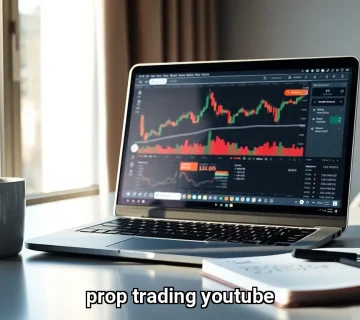Navigating the world of trading can feel overwhelming, especially when you’re asking which prop firms allow grid trading, like Propx Pro, to match your unique strategies. In the realm of prop trading, Propx Pro shines by supporting grid trading—a method that thrives on market fluctuations through multiple buy and sell orders at set intervals. The challenge lies in mastering this strategy and finding a firm like Propx Pro that embraces it, as not all prop firms have the same policies, with some restricting or banning grid trading during evaluations while Propx Pro offers flexibility to align with your approach.
This article aims to demystify the landscape of prop firms that support grid trading, spotlighting Propx Pro’s role. We’ll explore how it defines grid trading, the strategy’s potential advantages, and key factors to consider when choosing it for your trading style. Whether you’re an experienced trader refining your skills or a newcomer eager to dive into grid trading, understanding Propx Pro’s stance is essential. Join us as we uncover how it empowers grid traders and positions you for success in today’s dynamic trading environment!
Which Prop Firms Allow Grid Trading
Grid trading is a unique trading strategy that involves placing multiple buy and sell orders at predefined intervals, creating a grid-like structure on the price chart. As traders seek opportunities to capitalize on market fluctuations, understanding which prop firms allow grid trading becomes paramount for those looking to leverage this strategy. Prop firms, or prop firm trading, typically have specific rules and requirements for trading methodologies, and grid trading is often scrutinized due to its potential implications for risk management and market behavior.
A thorough understanding of these regulations will empower traders to make informed decisions about their trading strategies. By aligning their methods with the policies of their chosen prop firms, traders can better position themselves for success and avoid potential pitfalls that may arise from non-compliance.
The landscape of prop firms is diverse, each with its own set of rules governing trading strategies. Some prop firms permit grid trading strategies during the evaluation phase, allowing traders to demonstrate their skills and profitability before transitioning to different trading methods once they are fully funded. In contrast, others may have stricter policies, prohibiting grid trading altogether due to concerns about market manipulation or excessive risk exposure. It’s essential for traders to thoroughly research and understand the regulations of each firm to align their trading strategies with the firm’s policies. This diligence can make all the difference in a trader’s success, as being well-informed about the rules and guidelines can help avoid unexpected challenges and setbacks.

Understanding Grid Trading in Prop Firms
Grid trading operates on the principle of capitalizing on market volatility by placing multiple orders at set intervals. This method can be particularly effective in ranging markets, where prices oscillate between defined highs and lows. However, prop firms often evaluate this approach with caution. For instance, Propx Pro has a specific definition of grid trading that highlights its concern for potential market manipulation and the risks associated with opposing buy and sell orders. Understanding the nuances of grid trading is crucial for traders wishing to adopt this strategy within the constraints of prop firm rules. The ability to navigate these complexities can significantly enhance a trader’s effectiveness and overall profitability.
Traders should also be aware that grid trading may not be universally recognized across different firms. The definition of grid trading can vary significantly, and what one firm permits may be entirely different from another’s stance. For example, while some firms may allow grid trading during the evaluation phase, they might restrict it once a trader is fully funded. This discrepancy underscores the importance of engaging with the firm’s support team or resources to clarify their specific rules regarding grid trading. By actively seeking clarification, traders can ensure they have a solid understanding of what is permissible, allowing them to plan their strategies effectively and avoid potential violations.
Top Prop Firms for Grid Trading Strategies
When exploring which prop firms allow grid trading, it’s beneficial to consider those that are known for their flexibility and accommodating trading environments. Some firms may even provide proprietary trading software or automated trading systems designed to optimize grid trading strategies. For example, Surgefunded EAs is a well-regarded automated trading system that demonstrates consistent performance and high win rates, making it a suitable option for traders interested in grid trading. However, not all prop firms will support the use of trading EAs (Expert Advisors) for grid trading.
Therefore, it’s imperative for traders to ensure that the EAs they intend to use comply with the specific trading rules of their chosen prop firm. Additionally, the ability to modify risk parameters dynamically is a crucial feature for traders employing grid strategies, as market conditions can change rapidly. This adaptability can be critical in maintaining profitability and adhering to the firm’s guidelines.
Grid Trading: A Guide for Prop Traders
For traders considering grid trading as a viable strategy within prop firms, understanding the key components of successful implementation is essential. This includes familiarizing oneself with the firm’s risk management guidelines, as these will dictate how traders can operate their grid trading systems. It is advisable to conduct thorough backtesting against historical data to evaluate the performance of grid trading strategies under various market conditions. Such analysis can help traders identify potential weaknesses in their strategies and adjust their approaches accordingly. Additionally, being well-versed in risk management practices will ensure that traders can navigate the complexities of grid trading effectively.
Moreover, traders should remain vigilant in monitoring their trading systems to ensure they are functioning as intended and adapting to market changes. Respecting risk management principles is paramount; traders must set appropriate lot sizes and adhere to drawdown limits as specified by the firm. This diligence will not only help maintain compliance with the firm’s regulations but also safeguard traders’ capital. By implementing robust monitoring processes and continuously refining their strategies, traders can enhance their performance and improve their chances of success within the prop trading environment.

Evaluating Prop Firms That Support Grid Trading
When evaluating prop firms for their support of grid trading, several key factors should be considered. Firstly, traders should assess the firm’s specific policies regarding grid trading, including any limitations or requirements that may be in place. Understanding these policies will help traders align their strategies with the firm’s expectations and avoid potential issues down the line. Additionally, it is important to look for firms that provide educational resources or mentorship opportunities to help traders refine their strategies. Access to such resources can be invaluable, particularly for newer traders who may still be developing their skills and understanding of the markets.
Another element to consider is the firm’s reputation and track record within the trading community. Traders should seek feedback from current and former members to gauge the level of support and resources provided by the firm. A reputable prop firm will have transparent policies and engage with its traders to foster a productive trading environment. By choosing a firm with a strong reputation, traders can feel more confident in their decision and focus on honing their trading skills rather than worrying about compliance or support issues.
Benefits of Grid Trading in Prop Firms
Grid trading offers several advantages for traders operating within a prop firm environment. One of the primary benefits is the potential for consistent returns in volatile markets. By strategically placing buy and sell orders at predetermined intervals, traders can effectively capitalize on price fluctuations without needing to predict market direction. This can be especially beneficial for traders who may not have the time or expertise to perform detailed market analysis. Additionally, grid trading allows for a diversified approach to trading. By simultaneously holding multiple positions, traders can reduce the impact of adverse price movements in any single trade.
This can lead to a more stable equity curve and enhanced overall trading performance. Furthermore, grid trading can be automated, enabling traders to execute their strategies with minimal manual intervention, freeing them to focus on other aspects of trading or personal development. Ultimately, these benefits make grid trading an attractive option for many traders looking to optimize their performance and achieve their financial goals.
Empowering Your Grid Trading Journey
In summary, navigating the landscape of proprietary trading firms while implementing grid trading strategies requires a comprehensive understanding of firm policies and risk management practices. Each prop firm presents unique guidelines that can significantly impact a trader’s approach, particularly with respect to grid trading. By identifying firms that not only permit but also support this trading methodology, traders can enhance their opportunities for success. Moreover, the advantages of grid trading—such as capitalizing on market volatility and diversifying positions—can lead to more stable returns and a more efficient trading process.
As you embark on this journey, remember to prioritize research, engage with firm representatives, and continuously refine your strategies based on market conditions. This proactive approach will empower you to navigate the complexities of prop trading and harness the full potential of grid trading in your trading arsenal. Ultimately, aligning your trading style with the right prop firm can pave the way for a fruitful and rewarding trading experience.




No comment